Abstract
STUDY OBJECTIVE--This paper describes the objectives, design, and methods of evaluation of the impact of the coeur en santé St-Henri programme, as well as selected results from the evaluation to date. It discusses the possible effects of study design choices made to maintain the impact evaluation within budget. DESIGN--The impact of the programme is evaluated in a community trial which compares the prevalence of cardiovascular disease behavioural risk factors before and after programme implementation in the intervention and a matched comparison community, in both longitudinal cohort and independent sample surveys. In addition, repeated independent sample surveys are conducted in the intervention community to monitor awareness of and participation in the programme. PARTICIPANTS--The baseline sample for both the longitudinal cohort and independent sample surveys included 849 subjects from the intervention community (79.3% of 1071 eligible subjects--8.0% could not be contacted and 12.6% refused) and 825 subjects from the comparison community (77.8% of 1066 eligible subjects--6.6% could not be contacted and 15.6% refused). The two surveys on awareness and participation conducted to date, included 461 (71.0% of 649 eligible subjects) and 387 (67.9% of 570 eligible subjects) subjects respectively from the intervention community. MEASUREMENTS--Baseline data for the longitudinal cohort and independent sample surveys on behavioural risk factor outcomes including use of tobacco, physical activity behaviour, high fat diet, and behaviours related to blood pressure and cholesterol control were collected in 35 minute telephone interviews in both the intervention and comparison communities. Data on awareness of and participation in the programme were collected in 10 minute interviews in the intervention community only in two independent sample surveys conducted seven and 22 months respectively after the baseline survey. RESULTS--With the exception of smoking, the intervention and comparison communities were similar at baseline with regard to the prevalence of behavioural risk factors studied. Awareness of the coeur en santé programme increased from 64.1% in January 1993 to 72.9% 15 months later. Participation in the programme increased from 21.3% to 33.7%. CONCLUSIONS--This paper presents background information on the evaluation of the impact of the coeur en santé programme, as a reference for future publications.
Full text
PDF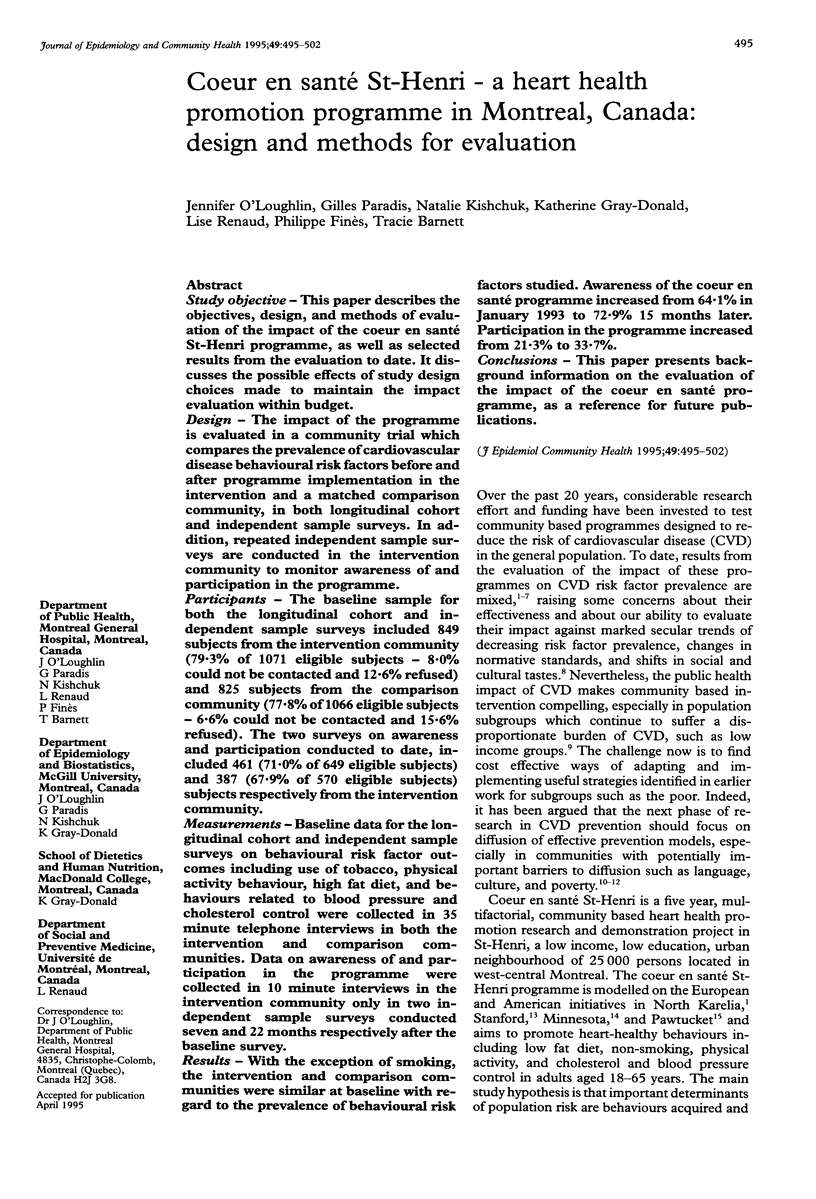
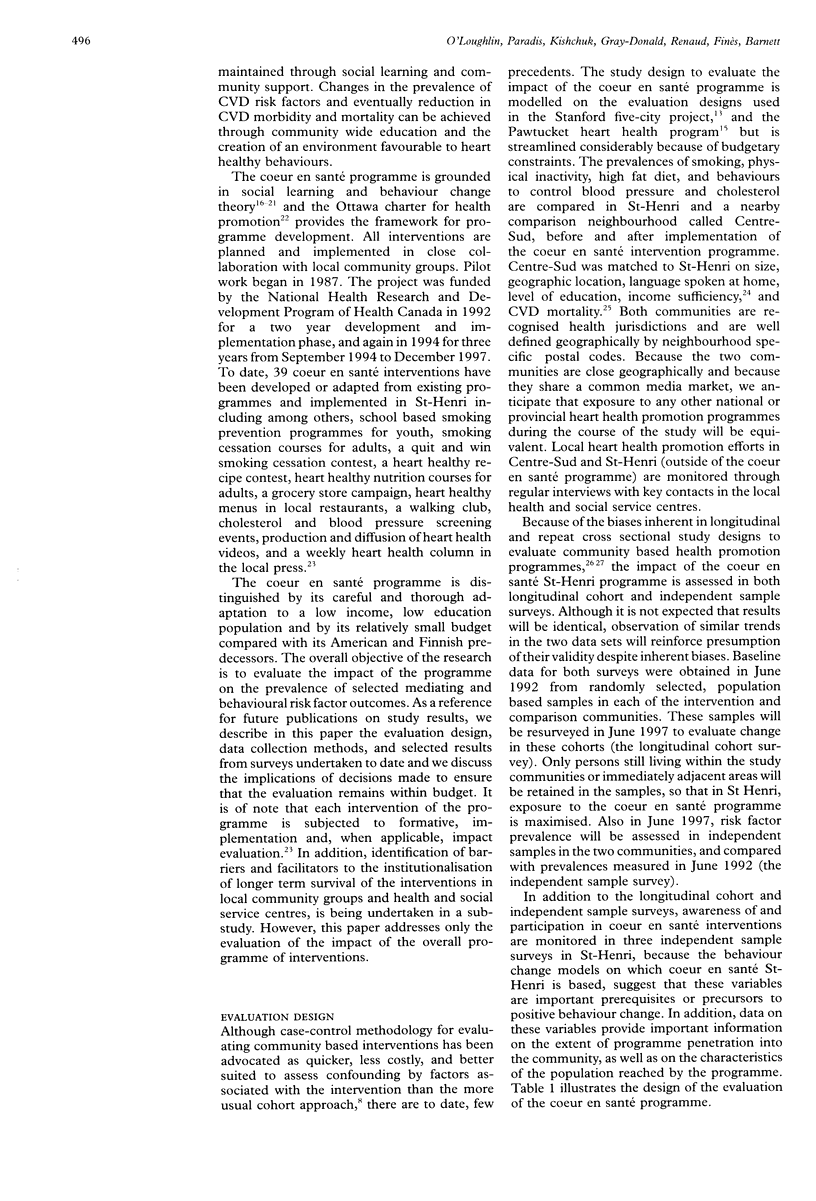
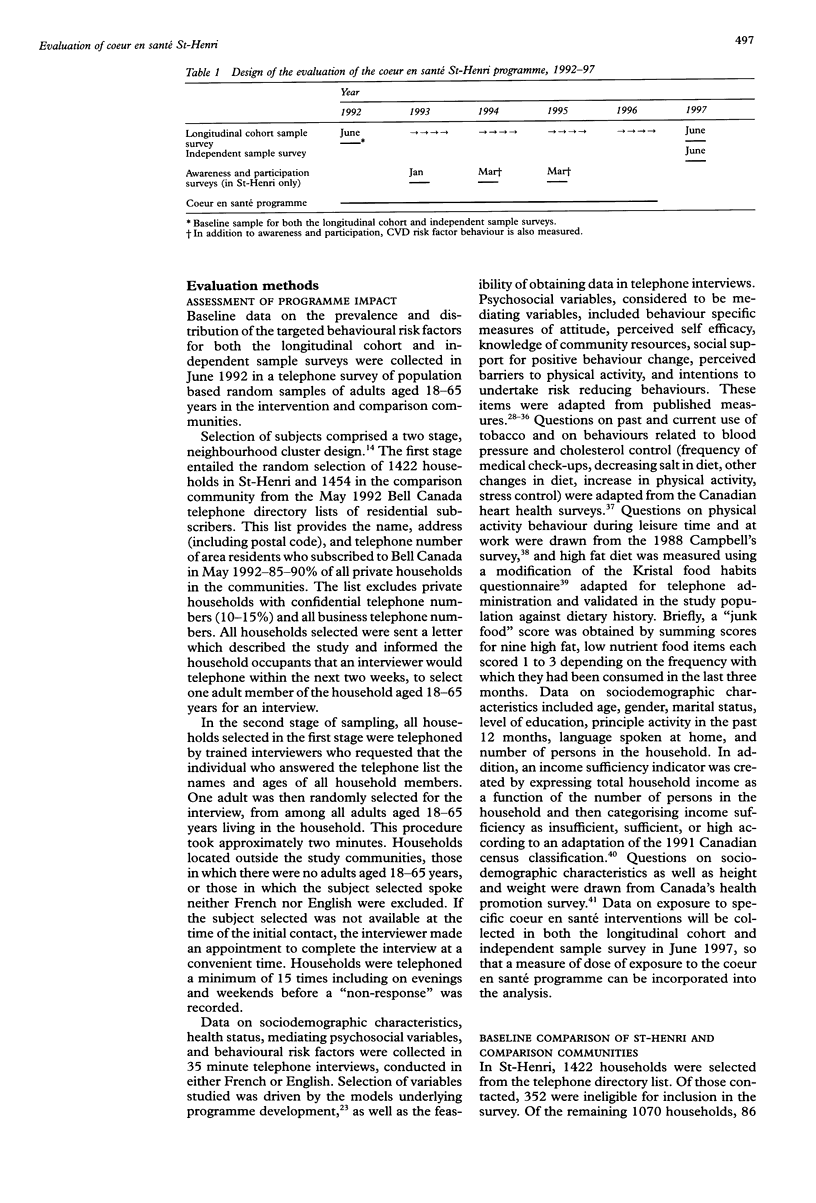

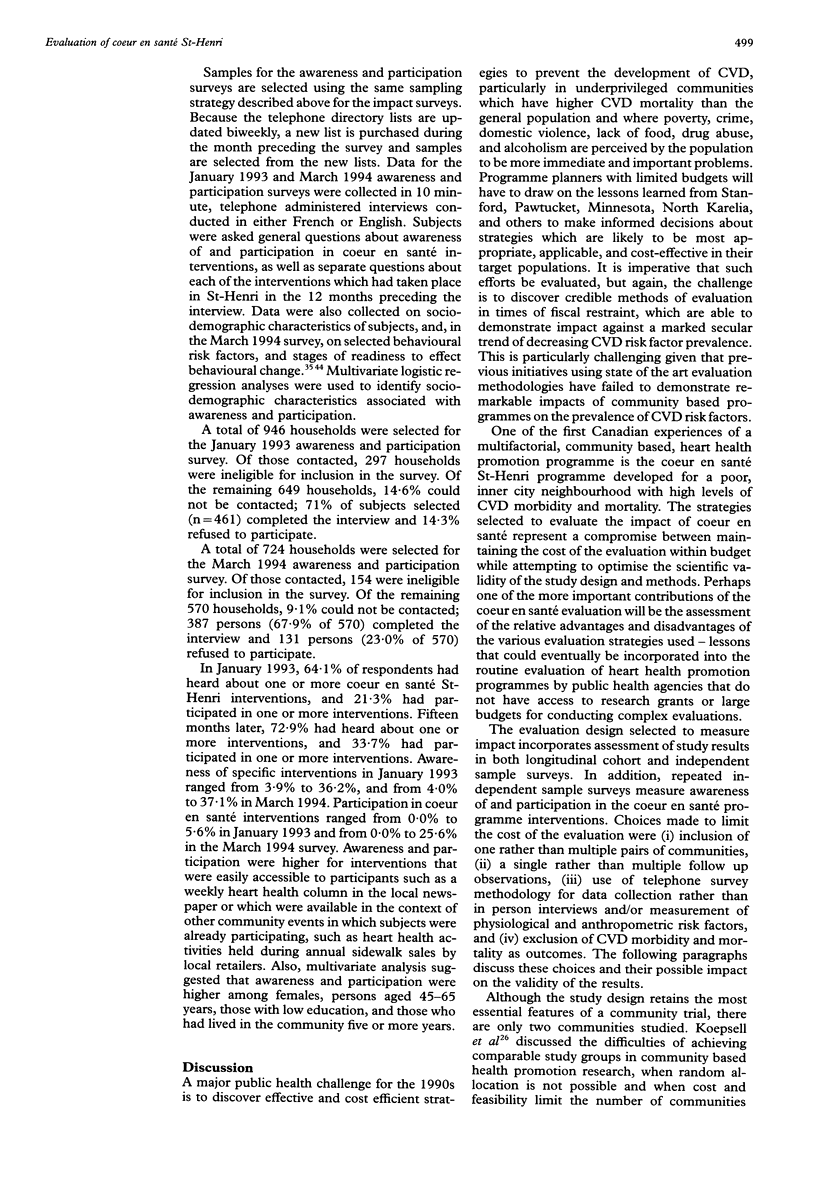
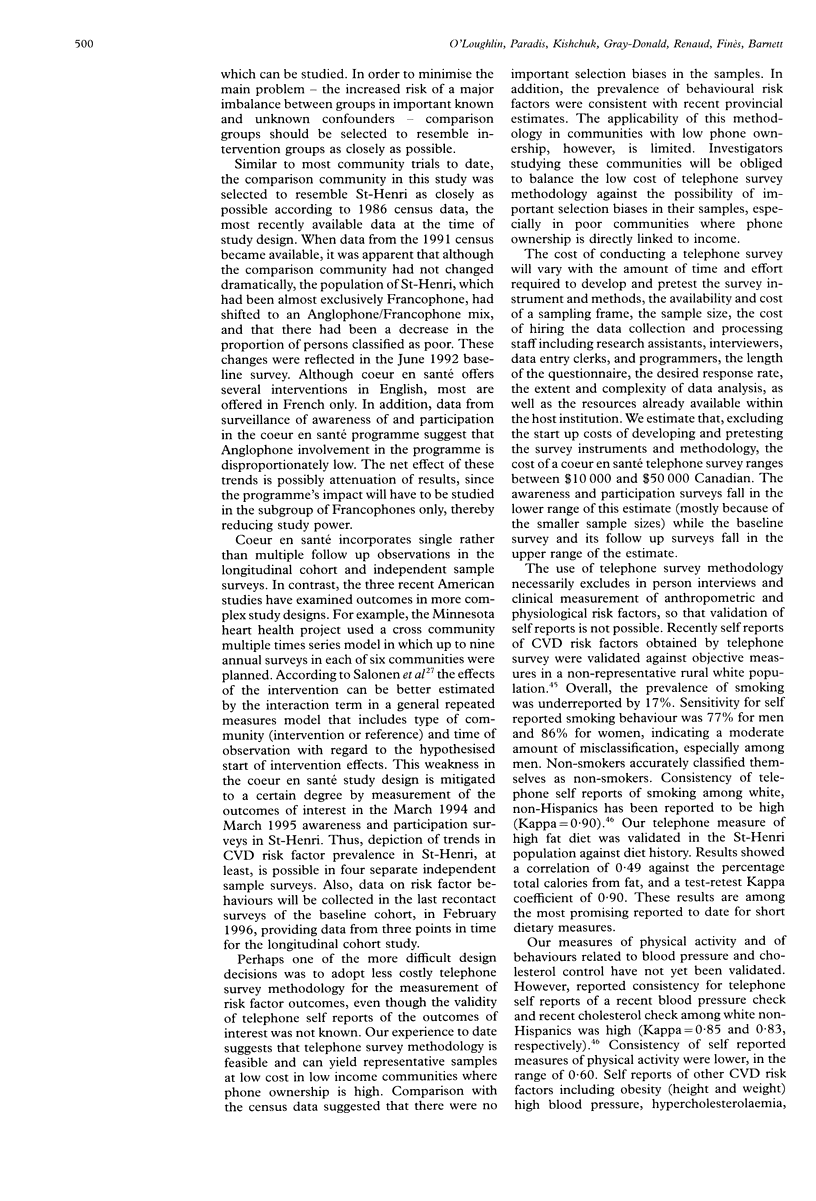
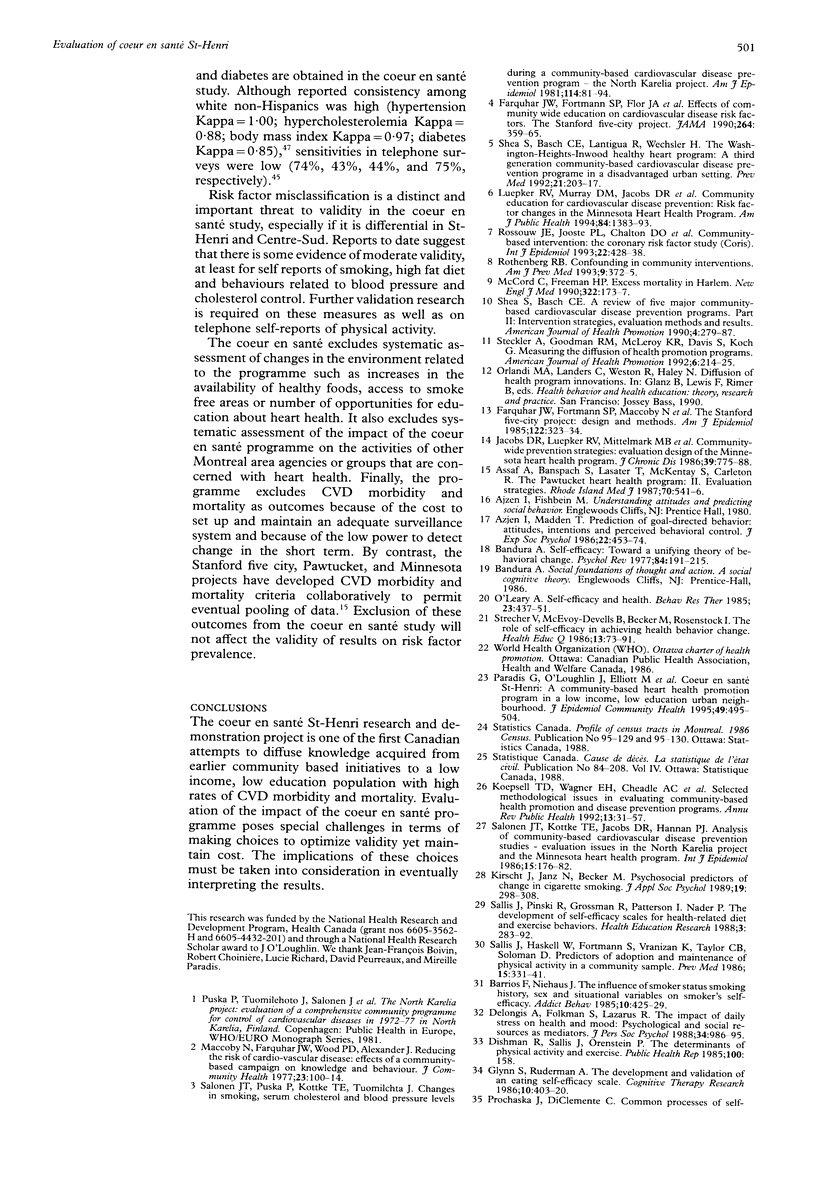

Selected References
These references are in PubMed. This may not be the complete list of references from this article.
- Assaf A. R., Banspach S. W., Lasater T. M., McKinlay S. M., Carleton R. A. The Pawtucket Heart Health Program: II. Evaluation strategies. R I Med J. 1987 Dec;70(12):541–546. [PubMed] [Google Scholar]
- Bandura A. Self-efficacy: toward a unifying theory of behavioral change. Psychol Rev. 1977 Mar;84(2):191–215. doi: 10.1037//0033-295x.84.2.191. [DOI] [PubMed] [Google Scholar]
- Barrios F. X., Niehaus J. C. The influence of smoker status, smoking history, sex, and situational variables on smokers' self-efficacy. Addict Behav. 1985;10(4):425–429. doi: 10.1016/0306-4603(85)90040-1. [DOI] [PubMed] [Google Scholar]
- Bowlin S. J., Morrill B. D., Nafziger A. N., Jenkins P. L., Lewis C., Pearson T. A. Validity of cardiovascular disease risk factors assessed by telephone survey: the Behavioral Risk Factor Survey. J Clin Epidemiol. 1993 Jun;46(6):561–571. doi: 10.1016/0895-4356(93)90129-o. [DOI] [PubMed] [Google Scholar]
- Dishman R. K., Sallis J. F., Orenstein D. R. The determinants of physical activity and exercise. Public Health Rep. 1985 Mar-Apr;100(2):158–171. [PMC free article] [PubMed] [Google Scholar]
- Farquhar J. W., Fortmann S. P., Flora J. A., Taylor C. B., Haskell W. L., Williams P. T., Maccoby N., Wood P. D. Effects of communitywide education on cardiovascular disease risk factors. The Stanford Five-City Project. JAMA. 1990 Jul 18;264(3):359–365. [PubMed] [Google Scholar]
- Farquhar J. W., Fortmann S. P., Maccoby N., Haskell W. L., Williams P. T., Flora J. A., Taylor C. B., Brown B. W., Jr, Solomon D. S., Hulley S. B. The Stanford Five-City Project: design and methods. Am J Epidemiol. 1985 Aug;122(2):323–334. doi: 10.1093/oxfordjournals.aje.a114104. [DOI] [PubMed] [Google Scholar]
- Hannan P. J., Murray D. M., Jacobs D. R., Jr, McGovern P. G. Parameters to aid in the design and analysis of community trials: intraclass correlations from the Minnesota Heart Health Program. Epidemiology. 1994 Jan;5(1):88–95. doi: 10.1097/00001648-199401000-00013. [DOI] [PubMed] [Google Scholar]
- Jacobs D. R., Jr, Luepker R. V., Mittelmark M. B., Folsom A. R., Pirie P. L., Mascioli S. R., Hannan P. J., Pechacek T. F., Bracht N. F., Carlaw R. W. Community-wide prevention strategies: evaluation design of the Minnesota Heart Health Program. J Chronic Dis. 1986;39(10):775–788. doi: 10.1016/0021-9681(86)90080-9. [DOI] [PubMed] [Google Scholar]
- Koepsell T. D., Wagner E. H., Cheadle A. C., Patrick D. L., Martin D. C., Diehr P. H., Perrin E. B., Kristal A. R., Allan-Andrilla C. H., Dey L. J. Selected methodological issues in evaluating community-based health promotion and disease prevention programs. Annu Rev Public Health. 1992;13:31–57. doi: 10.1146/annurev.pu.13.050192.000335. [DOI] [PubMed] [Google Scholar]
- Kristal A. R., Shattuck A. L., Henry H. J. Patterns of dietary behavior associated with selecting diets low in fat: reliability and validity of a behavioral approach to dietary assessment. J Am Diet Assoc. 1990 Feb;90(2):214–220. [PubMed] [Google Scholar]
- Luepker R. V., Murray D. M., Jacobs D. R., Jr, Mittelmark M. B., Bracht N., Carlaw R., Crow R., Elmer P., Finnegan J., Folsom A. R. Community education for cardiovascular disease prevention: risk factor changes in the Minnesota Heart Health Program. Am J Public Health. 1994 Sep;84(9):1383–1393. doi: 10.2105/ajph.84.9.1383. [DOI] [PMC free article] [PubMed] [Google Scholar]
- MacLean D. R., Petrasovits A., Nargundkar M., Connelly P. W., MacLeod E., Edwards A., Hessel P. Canadian heart health surveys: a profile of cardiovascular risk. Survey methods and data analysis. Canadian Heart Health Surveys Research Group. CMAJ. 1992 Jun 1;146(11):1969–1974. [PMC free article] [PubMed] [Google Scholar]
- Maccoby N., Farquhar J. W., Wood P. D., Alexander J. Reducing the risk of cardiovascular disease: effects of a community-based campaign on knowledge and behavior. J Community Health. 1977 Winter;3(2):100–114. doi: 10.1007/BF01674232. [DOI] [PubMed] [Google Scholar]
- McCord C., Freeman H. P. Excess mortality in Harlem. N Engl J Med. 1990 Jan 18;322(3):173–177. doi: 10.1056/NEJM199001183220306. [DOI] [PubMed] [Google Scholar]
- O'Leary A. Self-efficacy and health. Behav Res Ther. 1985;23(4):437–451. doi: 10.1016/0005-7967(85)90172-x. [DOI] [PubMed] [Google Scholar]
- Rossouw J. E., Jooste P. L., Chalton D. O., Jordaan E. R., Langenhoven M. L., Jordaan P. C., Steyn M., Swanepoel A. S., Rossouw L. J. Community-based intervention: the Coronary Risk Factor Study (CORIS). Int J Epidemiol. 1993 Jun;22(3):428–438. doi: 10.1093/ije/22.3.428. [DOI] [PubMed] [Google Scholar]
- Rothenberg R. B. Confounding in community interventions. Am J Prev Med. 1993 Nov-Dec;9(6):372–377. [PubMed] [Google Scholar]
- Sallis J. F., Haskell W. L., Fortmann S. P., Vranizan K. M., Taylor C. B., Solomon D. S. Predictors of adoption and maintenance of physical activity in a community sample. Prev Med. 1986 Jul;15(4):331–341. doi: 10.1016/0091-7435(86)90001-0. [DOI] [PubMed] [Google Scholar]
- Salonen J. T., Kottke T. E., Jacobs D. R., Jr, Hannan P. J. Analysis of community-based cardiovascular disease prevention studies--evaluation issues in the North Karelia Project and the Minnesota Heart Health Program. Int J Epidemiol. 1986 Jun;15(2):176–182. doi: 10.1093/ije/15.2.176. [DOI] [PubMed] [Google Scholar]
- Salonen J. T., Puska P., Kottke T. E., Tuomilehto J. Changes in smoking, serum cholesterol and blood pressure levels during a community-based cardiovascular disease prevention program--the North Karelia Project. Am J Epidemiol. 1981 Jul;114(1):81–94. doi: 10.1093/oxfordjournals.aje.a113177. [DOI] [PubMed] [Google Scholar]
- Shea S., Basch C. E. A review of five major community-based cardiovascular disease prevention programs. Part II: Intervention strategies, evaluation methods, and results. Am J Health Promot. 1990 Mar-Apr;4(4):279–287. doi: 10.4278/0890-1171-4.4.279. [DOI] [PubMed] [Google Scholar]
- Shea S., Basch C. E., Lantigua R., Wechsler H. The Washington Heights-Inwood Healthy Heart Program: a third generation community-based cardiovascular disease prevention program in a disadvantaged urban setting. Prev Med. 1992 Mar;21(2):203–217. doi: 10.1016/0091-7435(92)90019-e. [DOI] [PubMed] [Google Scholar]
- Steckler A., Goodman R. M., McLeroy K. R., Davis S., Koch G. Measuring the diffusion of innovative health promotion programs. Am J Health Promot. 1992 Jan-Feb;6(3):214–224. doi: 10.4278/0890-1171-6.3.214. [DOI] [PubMed] [Google Scholar]
- Stein A. D., Lederman R. I., Shea S. The Behavioral Risk Factor Surveillance System questionnaire: its reliability in a statewide sample. Am J Public Health. 1993 Dec;83(12):1768–1772. doi: 10.2105/ajph.83.12.1768. [DOI] [PMC free article] [PubMed] [Google Scholar]
- Strecher V. J., DeVellis B. M., Becker M. H., Rosenstock I. M. The role of self-efficacy in achieving health behavior change. Health Educ Q. 1986 Spring;13(1):73–92. doi: 10.1177/109019818601300108. [DOI] [PubMed] [Google Scholar]


